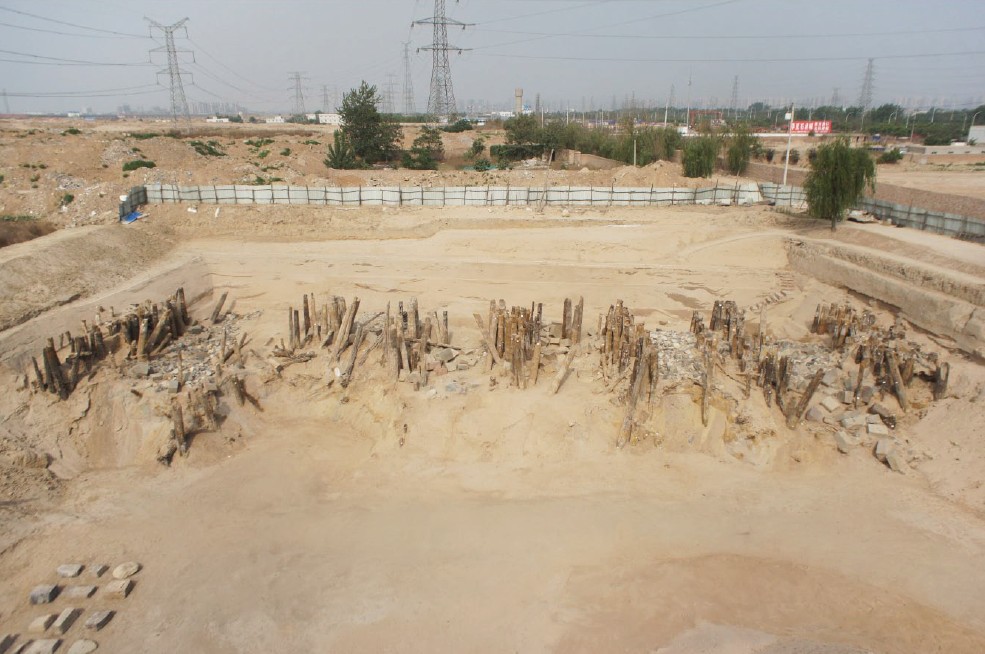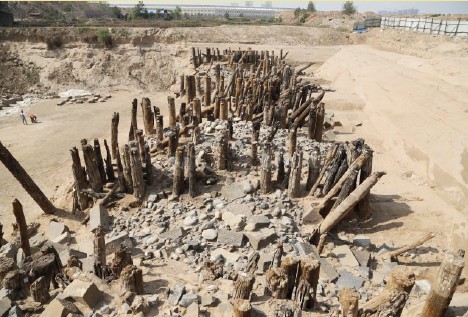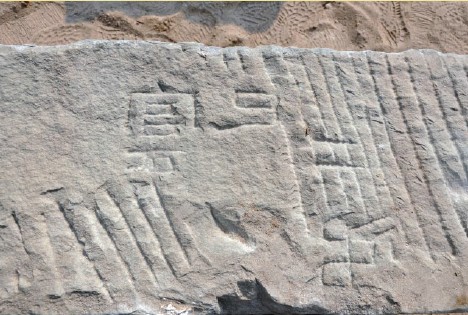The 2013 New Discovery of Wei River Bridge Site in Xi’an
From:Chinese Archaeology NetWriter:Date:2014-01-16
The Wei Bridge Site seated near the south of Han Dynasty’s Chang’an City Site in the north suburb of Xi’an City. Since the site was found in the April of 2012, Institute of Shanxi Province Archeology, Institute of Archaeology Chinese Academy of Social Sciences and Xi’an Municipal Cultural Relics Conservation and Archeology Institute joint together as a Wei Bridge site archeological team conducted salvage excavation. Through a year’s investigation and excavation, 7 bridges of 3 groups was found to the north and northeast part of Han Dynasty’s Chang’an City Site. Facing to City Gate Chu in the middle part of Chang’an City Site’s south wall, a group of 5 bridges was found, and numbered as Chu-gate Bridge 1 to 5; there’s one found outside City Gate Luo, named as Luo-gate Bridge; 10 kilometer southeast to Luo-gate Bridge, and south to Yanglingyi’s Wangjiawan found one, named as Wangjiawan Wei-Bridge.

sketch map of the location of Wei River Bridge site, ancient city site of Qin-Han Dynasties and Mausoleum
Chu-gate Bridge 1 was south-north wooden beam-column bridge, 15.4 meters between east and west bridge pier. After geophysical prospecting, spade probing and pre-excavation, the bridge was measured over 880 meters in length. Each pier’s bottom was tapered and hammered into the river bed over 1 meter deep, the damaged length ranging from 6.2 to 8.8 meters, and perimeter was 0.5 to 1.5 meters. The bridge piers were placed along the flow direction of the river, from east to west, the space between the south and north lines were different, ranging from 3 to 7 meters. The wooden material of Chu-gate Bridge and Luo-gate Bridge’s piers was nanmu, hemlock, sabina chinensis, cedrela sinensis, elm, and robur, ect. During the excavation of Chu-gate Bridge 1, there found large amount of bluestone and sandstone component in rectangle, square, pentagon, and trapezoid shape, most of which bore carving and ink inscription, the content of them were numbers and names. Considering the unearthed “Kangxi Tongbao” Coins from Chu-gate Bridge 1, the earliest age of sand layer buried the bridge couldn’t be earlier than the age of Kangxi Emperor’s reign. PKU’s lab carbon 14 result suggested the age of Chu-gate Bridge 1 was ranging from 380 BC to 330 BC.

remains of Chu-gate Bridge 1

details of Chu-gate Bridge 1
400 meters areas from east to west around Chu-gate Bridge 1, we found 5 large ancient bridges, which is the first time in archeological discovery. According to the preliminary carbon 14 test, Chu-gate Bridge 1 was lasted from Warring States period to Wei and Jin Dynasties, or even later. The piers’ age of Chu-gate Bridge 3 ranged from 250 to 780 AD, which belong to Wei-Jin dynasties to Sui-Tang dynasties. The two bridges had obvious continuity in age and construction technique, while the time span of them reached a thousand year, suggesting the bridges’ location outside Gate Chu was very important. The Wei River Bridge hadn’t been found yet outside the Heng-gate, while the group of bridges located outside Gate Chu could be the “middle Wei River Bridge” for a period. The discovery of the bridges not only provided great materials for the study of ancient bridges’ history, but also significant to the study of ancient Xianyang City Site of Qin Dynasty and Chang’an City Site of Han Dynasty. As the world largest wooden beam-column bridge discovered, it was the first bridge from Chang’an city of Han dynasty on silk road, playing a significant role in social, cultural, and military aspects in Qin and Han dynasties, possessing magnificent connotation in history and culture.

schematic diagram of the distribution of the bridge pier on Chu-gate Bridge 1

inscription on the stone architectural component from Chu-gate Bridge 1
From the “Kangxi Tongbao” Coins and other remaining of Qing Dynasty found in Chu-gate Bridge 1, the age of it could be determined as late as Emperor Kangxi’s reign, the main stream of River Wei was still located in the excavation area, which is 3 kilometers away from the current drainage line, suggesting that the shifting of River Wei to north couldn’t be earlier than Emperor Kangxi’s reign, therefore, the academic conclusion, “From Qin and Han Dynasties, River Wei had been gradually shifting to north about 1 to 2 meters per year”, was false. The shifting of River Wei to north happened during or after Emperor Kangxi’s reign, and the shifting process was fast, which was essential for the study of River Wei’s change and the central Shanxi plain’s environment. (Translator: Lang Langtian)

